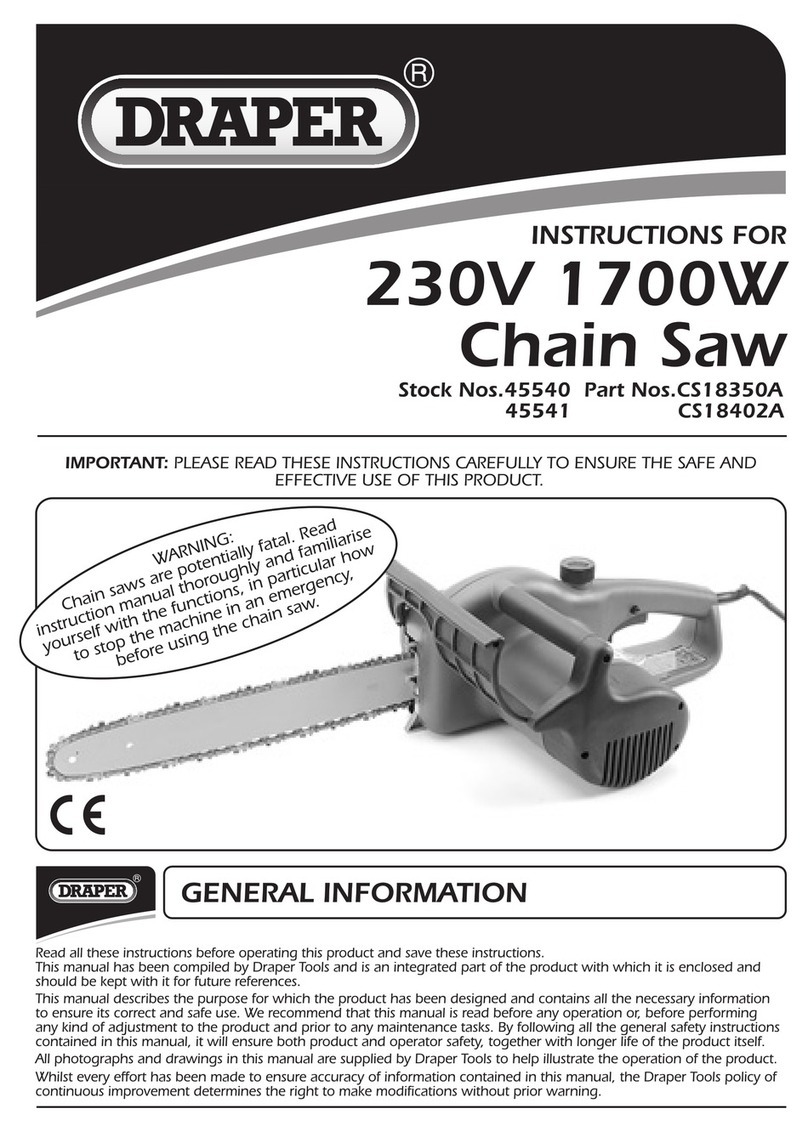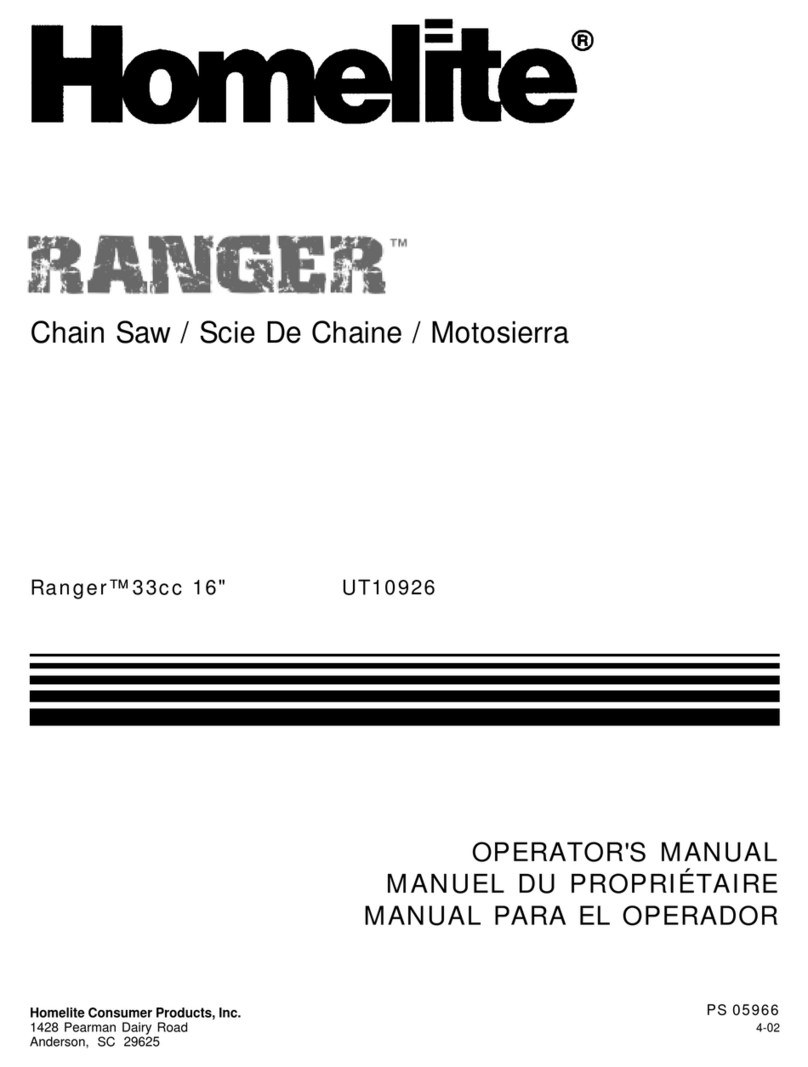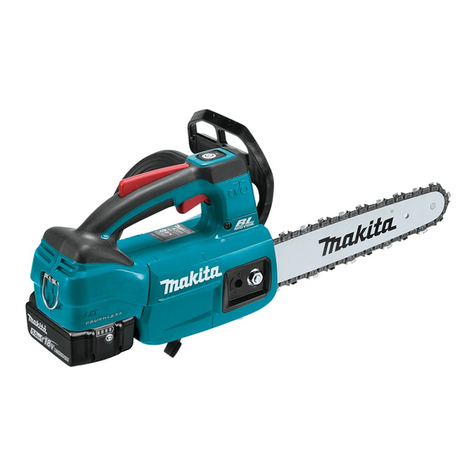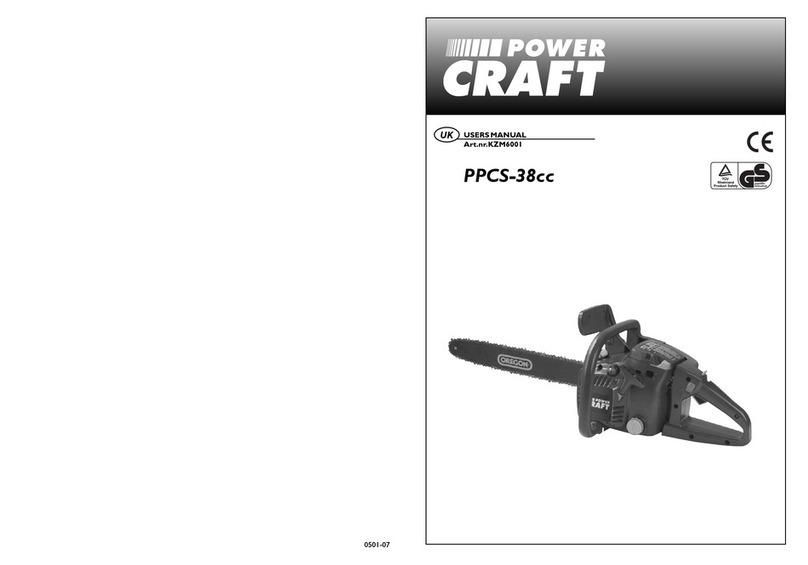SKI CS1800C-00 User manual

WARNING: To reduce the risk of injury, the user must read and understand the
Owner’s Manual before using this product. Save these instructions for future reference.
AVERTISSEMENT : Afin de réduire les risques de blessure, l’utilisateur doit lire et
comprendre le guide d’utilisation avant d’utiliser cet article. Conservez le présent guide
afin de pouvoir le consulter ultérieurement.
ADVERTENCIA : Para reducir el riesgo de lesiones, el usuario debe leer y comprender
el Manual del operador antes de utilizar este producto. Guarde estas instrucciones para
consultarlas en caso sea necesario.
Owner’s Manual
Guide d’utilisation
Manual del propietario
For Customer Service
Pour le service à la clientèle
Servicio al cliente 1-877-SKIL-999 OR www.skil.com
Brushless 40V 18" Chain Saw
Scie à chaîne sans balais de 40 V, 18 po
Motosierra de 18 pulgadas de 40 V sin escobillas
Model/ Modelo/ Modèle: CS1800C-00

2
TABLE OF CONTENTS
General Machine Safety Warnings..................................3
Chain Saw Safety Warnings .......................................5
Additional Warnings .............................................8
Symbols ......................................................10
Get To Know Your Chain Saw.....................................14
Specications .................................................15
Recommended Bar And Chain For This Chain Saw ..................15
Operating Instructions ..........................................17
Maintenance...................................................27
Troubleshooting ...............................................35
Limited Warranty Of Skil Consumer Machines.......................37
WARNING Drilling, sawing, sanding or machining wood products can expose you to
wood dust, a substance known to the State of California to cause cancer.
Avoid inhaling wood dust or use a dust mask or other safeguards for personal protection. For
more information go to www.P65Warning.ca.gov/wood.
WARNING Some dust created by power sanding, sawing, grinding, drilling and other
construction activities contains chemicals known to the State of California
to cause cancer, birth defects or other reproductive harm. Some examples of these chemicals
are:
– Lead from lead-based paints.
– Crystalline silica from bricks, cement, and other masonry products.
– Arsenic and chromium from chemically-treated lumber.
Your risk from these exposures varies, depending upon how often you do this type of work. To
reduce your exposure to these chemicals:
– Work in a well-ventilated area.
– Work with approved safety equipment, such as dust masks that are specially designed to
lter out microscopic particles.
– Avoid prolonged contact with dust from power sanding, sawing, grinding, drilling, and
other construction activities. Wear protective clothing and wash exposed areas with soap
and water. Allowing dust to get into your mouth or eyes or to lie on the skin may promote
absorption of harmful chemicals.

3
GENERAL MACHINE SAFETY WARNINGS
WARNING Read all safety warnings and all instructions. Failure to follow the
warnings and instructions may result in electric shock, re and/or serious
injury.
SAVE ALL WARNINGS AND INSTRUCTIONS FOR FUTURE
REFERENCE.
The term “machine” in the warnings refers to your mains-operated (corded) machine or
battery-operated (cordless) machine.
Work area safety
Keep work area clean and well lit. Cluttered or dark areas invite accidents.
Do not operate machines in explosive atmospheres, such as in the presence of
ammable liquids, gases or dust. Machines create sparks which may ignite the dust or
fumes.
Keep children and bystanders away while operating a machine. Distractions can cause
you to lose control.
Electrical safety
Machine plugs must match the outlet. Never modify the plug in any way. Do not use any
adapter plugs with earthed (grounded) machines. Unmodied plugs and matching outlets
will reduce risk of electric shock.
Avoid body contact with earthed or grounded surfaces, such as pipes, radiators,
ranges and refrigerators. There is an increased risk of electric shock if your body is earthed
or grounded.
Do not expose machines to rain or wet conditions. Water entering a machine will increase
the risk of electric shock.
Do not abuse the cord. Never use the cord for carrying, pulling or unplugging the
machine. Keep cord away from heat, oil, sharp edges or moving parts. Damaged or
entangled cords increase the risk of electric shock.
When operating a machine outdoors, use an extension cord suitable for outdoor use.
Use of a cord suitable for outdoor use reduces the risk of electric shock.
If operating a machine in a damp location is unavoidable, use a ground fault circuit
interrupter (GFCI) protected supply. Use of a GFCI reduces the risk of electric shock.
Personal safety
Stay alert, watch what you are doing and use common sense when operating a
machine. Do not use a machine while you are tired or under the inuence of drugs,
alcohol or medication. A moment of inattention while operating machines may result in
serious personal injury.
Use personal protective equipment. Always wear eye protection. Protective equipment
such as a dust mask, non-skid safety shoes, hard hat or hearing protection used for
appropriate conditions will reduce personal injuries.
Prevent unintentional starting. Ensure the switch is in the off-position before
connecting to power source and/or battery pack, picking up or carrying the machine.
Carrying machines with your nger on the switch or energising machines that have the switch
on invites accidents.
Remove any adjusting key or wrench before turning the machine on. A wrench or a key
left attached to a rotating part of the machine may result in personal injury.
Do not overreach. Keep proper footing and balance at all times. This enables better
control of the machine in unexpected situations.

4
Dress properly. Do not wear loose clothing or jewellery. Keep your hair, clothing and
gloves away from moving parts. Loose clothes, jewellery or long hair can be caught in
moving parts.
If devices are provided for the connection of dust extraction and collection facilities,
ensure these are connected and properly used. Use of dust collection can reduce dust-
related hazards.
Do not let familiarity gained from frequent use of machines allow you to become
complacent and ignore machine safety principles. A careless action can cause severe
injury within a fraction of a second.
Machine use and care
Do not force the machine. Use the correct machine for your application. The correct
machine will do the job better and safer at the rate for which it was designed.
Do not use the machine if the switch does not turn it on and off. Any machine that cannot
be controlled with the switch is dangerous and must be repaired.
Disconnect the plug from the power source and/or remove the battery pack, if
detachable, from the machine before making any adjustments, changing accessories,
or storing machines. Such preventive safety measures reduce the risk of starting the
machine accidentally.
Store idle machines out of the reach of children and do not allow persons unfamiliar
with the machine or these instructions to operate the machine. Machines are dangerous
in the hands of untrained users.
Maintain machines and accessories. Check for misalignment or binding of moving
parts, breakage of parts and any other condition that may affect the machine’s
operation. If damaged, have the machine repaired before use. Many accidents are caused
by poorly maintained machines.
Keep cutting machines sharp and clean. Properly maintained cutting machines with sharp
cutting edges are less likely to bind and are easier to control.
Use the machine, accessories and machine bits etc. in accordance with these
instructions, taking into account the working conditions and the work to be performed.
Use of the machine for operations different from those intended could result in a hazardous
situation.
Keep handles and grasping surfaces dry, clean and free from oil and grease. Slippery
handles and grasping surfaces do not allow for safe handling and control of the machine in
unexpected situations.
Battery machine use and care
Recharge only with the charger specied by the manufacturer. A charger that is suitable
for one type of battery pack may create a risk of re when used with another battery pack.
Use machines only with specically designated battery packs. Use of any other battery
packs may create a risk of injury and re.
When battery pack is not in use, keep it away from other metal objects, like paper clips,
coins, keys, nails, screws or other small metal objects, that can make a connection
from one terminal to another. Shorting the battery terminals together may cause burns or a
re.
Under abusive conditions, liquid may be ejected from the battery; avoid contact. If
contact accidentally occurs, ush with water. If liquid contacts eyes, additionally seek
medical help. Liquid ejected from the battery may cause irritation or burns.
Do not use a battery pack or machine that is damaged or modied. Damaged or
modied batteries may exhibit unpredictable behavior resulting in re, explosion or risk
of injury.

5
Do not expose a battery pack or machine to re or excessive temperature. Exposure to
re or temperature above 265 °F (130 °C) may cause explosion.
Follow all charging instructions and do not charge the battery pack or machine
outside the temperature range specied in the instructions. Charging improperly or at
temperatures outside the specied range may damage the battery and increase the risk of
re.
Service
Have your machine serviced by a qualied repair person using only identical
replacement parts. This will ensure that the safety of the machine is maintained.
Never service damaged battery packs. Service of battery packs should only be performed
by the manufacturer or authorized service providers.
CHAIN SAW SAFETY WARNINGS
General chain saw safety warnings
a) Keep all parts of the body away from the saw chain when the chain saw is operating.
Before you start the chain saw, make sure that the saw chain is not contacting
anything. A moment of inattention while operating chain saws may cause entanglement of
your clothing or body with the chain.
b) Always hold the chain saw with your right hand on the rear handle and your left
hand on the front handle. Holding the chain saw with a reversed hand conguration
increases the risk of personal injury and should never be done.
c) Hold the chain saw by insulated gripping surfaces only, because the saw chain may
contact hidden wiring. Saw chains contacting a “live” wire may make exposed metal
parts of the machine “live” and could give the operator an electric shock.
d) Wear eye protection. Further protective equipment for hearing, head, hands, legs
and feet is recommended. Adequate protective equipment will reduce personal injury
from ying debris or accidental contact with the saw chain.
e) Do not operate a chain saw in a tree, on a ladder, from a rooftop, or any unstable
support. Operation of a chain saw in this manner could result in serious personal injury.
f) Always keep proper footing and operate the chain saw only when standing on xed,
secure and level surface. Slippery or unstable surfaces such as ladders may cause a
loss of balance or control of the chain saw.
g) When cutting a limb that is under tension, be alert for spring back. When the tension
in the wood bers is released, the spring loaded limb may strike the operator and/or throw
the chain saw out of control.
h) Use extreme caution when cutting brush and saplings. The slender material may
catch the saw chain and be whipped toward you or pull you off balance.
i) Carry the chain saw by the front handle with the chain saw switched off and away
from your body. When transporting or storing the chain saw always t the guide bar
cover. Proper handling of the chain saw will reduce the likelihood of accidental contact
with the moving saw chain.
j) Follow instructions for lubricating, chain tensioning and changing accessories.
Improperly tensioned or lubricated chain may either break or increase the chance for
kickback.
k) Cut wood only. Do not use chain saw for purposes not intended. For example:
do not use chain saw for cutting metal, plastic, masonry or non-wood building
materials. Use of the chain saw for operations different than intended could result in a
hazardous situation.
l) Do not attempt to fell a tree until you have an understanding of the risks and how to
avoid them. Serious injury could occur to the operator or bystanders while felling a tree.

6
m) Follow all instructions when clearing jammed material, storing or servicing the
chain saw. Make sure the switch is off and the battery pack is removed. Unexpected
actuation of the chain saw while clearing jammed material or servicing may result in
serious personal injury.
CAUSES AND OPERATOR PREVENTION OF KICKBACK
Kickback may occur when the nose or tip of the guide bar touches an object, or when the
wood closes in and pinches the saw chain in the cut.
Tip contact in some cases may cause a sudden reverse reaction, kicking the guide bar up and
back towards the operator.
Pinching the saw chain along the top of the guide bar may push the guide bar rapidly back
towards the operator.
Either of these reactions may cause you to lose control of the saw, which could result in
serious personal injury. Do not rely exclusively upon the safety devices built into your saw. As
a chain saw user, you should take several steps to keep your cutting jobs free from accident
or injury.
Kickback is the result of chain saw misuse and/or incorrect operating procedures or conditions
and can be avoided by taking proper precautions as given below:
• Maintain a rm grip, with thumbs and ngers encircling the chain saw handles, with
both hands on the saw and position your body and arm to allow you to resist kickback
forces. Kickback forces can be controlled by the operator, if proper precautions are taken.
Do not let go of the chain saw.
• Do not overreach and do not cut above shoulder height. This helps prevent unintended
tip contact and enables better control of the chain saw in unexpected situations.
• Only use replacement guide bars and saw chains specied by the manufacturer.
Incorrect replacement guide bars and saw chains may cause chain breakage and/or
kickback.
• Follow the manufacturer’s sharpening and maintenance instructions for the saw
chain. Decreasing the depth gauge height can lead to increased kickback.
• Do not operate a chain saw in a tree unless you have been specically trained to
do so. Operation of a chain saw in a tree without proper training could increase the risk of
serious personal injury.

7
KICKBACK SAFETY DEVICES ON
THIS CHAIN SAW
Chain Brake
The chain saw comes equipped with a chain
brake, which stops both the motor and the
motion of the chain when kickback occurs. The
chain brake can be activated by the forward
motion of the chain kickback brake paddle as
the saw rotates backward during kickback.
WARNING Never modify or attempt
to disable the chain
brake.
Make sure that the chain brake is working
properly before using the chain saw. The chain
kickback brake paddle should move back and forth easily.
To test the operation of the chain brake, perform the following steps (Fig. 1):
• Place the chain saw on a at bare surface and make sure no objects or obstructions that
could come in contact with the bar and chain are in the immediate vicinity.
• Disengage the chain brake by pulling the chain kickback brake paddle towards the front
handle.
• Install the battery pack and start the chain saw.
• Push the chain kickback brake paddle towards the front of the saw. A properly functioning
hand brake will stop the movement of the chain immediately. If the chain brake is not
working properly, do not use the chain saw until it has been repaired by a qualied service
technician.
WARNING Conrm that the chain brake works properly before each use.
WARNING If the chain brake is clogged with wood chips, the function of the
chain brake may deteriorate. Always keep the device clean.
Low Kickback Saw Chain
The rakers (depth gauges) ahead of each cutter can minimize the force of a kickback
reaction by preventing the cutters from digging in too deeply at the kickback zone. Only
use a replacement chain that is equivalent to the original chain or has been certied as a
low kickback chain per ANSI B175.1. A low kickback tooth saw chain is a chain that has
met the kickback performance requirements of ANSI B175.1 (American National Standard
for Machines - Gasoline-Powered Chain Saws - Safety Requirements) when tested on the
representative sample of chain saws below 3.8 c.i.d. specied in ANSI B175.1.
CAUTION As saw chains are sharpened during their useful life, they lose some of the
low kickback qualities and extra caution should be used.
Guide Bar
This saw comes equipped with a guide bar that has a small radius nose. Small radius noses
generally have less potential for kickback. When replacing the guide bar, please order the
guide bar we recommend in this manual.
Fig. 1 Chain kickback brake paddle
in brake position
Chain kickback brake paddle
in operating position

8
ADDITIONAL WARNINGS
A chain saw is intended for two-handed
use (Fig.2), with the right hand on the rear
handle and the left hand on the front handle.
Serious injury to the operator, helpers, and/
or bystanders can result from one-handed
operation.
Make sure that the area in which you are
cutting is free from obstructions. Do not let
the nose of the guide bar contact a log, branch,
fence, or any other obstruction that could be hit
while you are operating the saw.
Always cut with the unit running at full
speed. Fully squeeze the switch trigger and
maintain cutting speed.
With a basic understanding of kickback, you can reduce or eliminate the element of
surprise (Fig.3.4.5). Sudden surprise contributes to accidents.
Fig. 3
Rotational
Kickback
Fig. 4
Kickback
Danger Zone
Keep proper footing and balance at all
times.
Avoid unintentional contact with the
stationary saw chain or guide bar rails.
These can be very sharp. Always wear gloves
and long pants or chaps when handling the
chain saw, saw chain, or guide bar.
Never operate a chain saw that is damaged
or improperly adjusted or that is not
completely and securely assembled. Be
sure that the saw chain stops moving when the
trigger switch is released.
Do not incinerate the appliance even if it is
severely damaged. The batteries can explode
in a re.
Inspect the workpiece for nails, wire, or other foreign objects prior to cutting.
When bucking, secure the work piece prior to cutting. When felling or pruning, identify
and secure hazardous branches.
Fig. 2
Fig. 5 Linear Kickback
Pinch
Kickback

9
Aggressive or abusive cutting or misuse
of the chain saw can cause premature bar,
chain, and/or sprocket wear, as well as a
broken chain or bar, leading to kickback,
chain throw or the ejection of material.
Never use the guide bar as a lever. A bent
guide bar can cause premature bar, chain, and/
or sprocket wear, as well as a broken chain
or bar, leading to kickback, chain throw or the
ejection of material.
Cut only one work piece at a time.
Push and Pull – The reaction force is always
opposite to the direction the chain is moving
where wood contact is made. Thus, the
operator must be ready to control the PULL
when cutting on the bottom edge of the bar,
and the PUSH when cutting along the top
edge. See Figure 6.
Plan the work, ensuring an obstacle-free
work area and, in the case of felling, at least
one escape path from the falling tree.
When felling, keep bystanders at least two
tree lengths away.
If situations occur which are not covered in this
manual, use care and good judgment. Contact
SKIL Customer Service for assistance.
SAVE THESE INSTRUCTIONS!
Fig. 6
PULL
PUSH

10
SYMBOLS
Safety Symbols
The purpose of safety symbols is to attract your attention to possible dangers. The safety
symbols and the explanations with them deserve your careful attention and understanding.
The symbol warnings do not, by themselves, eliminate any danger. The instructions and
warnings they give are no substitutes for proper accident prevention measures.
WARNING Be sure to read and understand all safety instructions in this Owner’s
Manual, including all safety alert symbols such as “DANGER,”
“WARNING,” and “CAUTION” before using this machine. Failure to following all instructions
listed below may result in electric shock, re, and/or serious personal injury.
The denitions below describe the level of severity for each signal word. Please read the manual
and pay attention to these symbols.
This is the safety alert symbol. It is used to alert you to potential
personal injury hazards. Obey all safety messages that follow this
symbol to avoid possible injury or death.
DANGER DANGER indicates a hazardous situation which, if not avoided, will
result in death or serious injury.
WARNING WARNING indicates a hazardous situation which, if not avoided, could
result in death or serious injury.
CAUTION CAUTION, used with the safety alert symbol, indicates a hazardous
situation which, if not avoided, will result in minor or moderate injury.
Damage Prevention and Information Messages
These inform the user of important information and/or instructions that could lead to equipment
or other property damage if they are not followed. Each message is preceded by the word
“NOTICE”, as in the example below:
NOTICE Equipment and/or property damage may result if these instructions are not
followed.
WARNING The operation of any machines can result in foreign
objects being thrown into your eyes, which can result
in severe eye damage. Before beginning machine operation, always
wear safety goggles or safety glasses with side shields and a full face
shield when needed. We recommend a Wide Vision Safety Mask for use
over eyeglasses or standard safety glasses with side shields. Always
use eye protection which is marked to comply with ANSI Z87.1.

11
SYMBOLS (CONTINUED)
IMPORTANT: Some of the following symbols may be used on your machine. Please study
them and learn their meaning. Proper interpretation of these symbols will allow you to operate
the machine better and more safely.
Symbol Name Designation/Explanation
V Volts Voltage (potential)
AAmperes Current
Hz Hertz Frequency (cycles per second)
W Watt Power
kg Kilograms Weight
lb Pound Weight
ml Milliliter Volume
.oz Fluid Ounce Volume
min Minutes Time
s Seconds Time
Wh Watt-hours Battery capacity
Ah Ampere-Hours Battery capacity
ØDiameter Size of drill bits, grinding
wheels, etc.
n0No load speed Rotational speed, at no load
nRated speed Maximum attainable speed
…/min Revolutions or reciprocation per
minute
Revolutions, strokes, surface
speed, orbits, etc. per minute
SPM Strokes Per Minute Stroke speed, at no load
0Off position Zero speed, zero torque...
°C Degrees Celsius Temperature
°F Degrees Fahrenheit Temperature
IP... Ingress Protection (IP) Rating
Classies the degree of
protection provided by an
enclosure, for electrical
equipment.
Arrow Action in the direction of arrow
Direct current Type or a characteristic of
current

12
Symbol Name Designation/Explanation
Li-ion RBRC seal Designates Li-ion battery
recycling program
Read manual symbol Alerts user to read manual
Do not expose to rain. The machine can’t be used in
rain or let outside under raining.
Wear eye protection symbol
Always wear safety goggles or
safety glasses with side shields
and a full face shield when
operating this product.
Wear ear protection
Chain saw noise may damage
your hearing. Always wear
sound barriers (ear plugs or
ear mufers) to protect your
hearing.
Wear head protection Wear an approved safety hard
hat to protect your head.
Wear protective gloves
Protect your hands with gloves
when handling saw and saw
chain. Heavy-duty, nonslip
gloves improve your grip and
protect your hand.
Two handed hold Always use two hands when
operating the chain saw.
Be aware of kickback Contact of the guide bar tip with
any object should be avoided.
Guide bar tip kickback
Tip contact can cause the guide
bar to move suddenly upward
and backward, which can cause
serious injury.

13
SYMBOLS (CERTIFICATION INFORMATION)
IMPORTANT: Some of the following symbols for certication information may be used on your
machine. Please study them and learn their meaning. Proper interpretation of these symbols
will allow you to operate the machine better and more safely.
Symbol Designation/Explanation
This symbol designates that this machine is listed by Underwriters
Laboratories.
This symbol designates that this component is recognized by
Underwriters Laboratories.
This symbol designates that this machine is listed by Underwriters
Laboratories, to United States and Canadian Standards.
This symbol designates that this machine is listed by the Canadian
Standards Association.
This symbol designates that this machine is listed by the Canadian
Standards Association, to United States and Canadian Standards.
This symbol designates that this machine is listed by the Intertek
Testing Services, to United States and Canadian Standards.
This symbol designates that this machine complies to NOM Mexican
Standards.
This symbol designates that this machine is listed by German TÜV
Association.

14
GET TO KNOW YOUR CHAIN SAW
Chain Kickback Brake Paddle
Trigger Switch
Lock-off Button
Oil-Inspection Window
Battery-Release
Button
Saw Chain
Battery Ejector
Latch
Front Handle
Side Cover
Side-cover Knob
Chain Sheath
Guide Bar
Chain-Tensioning
Adjusting Knob
Rear Handle
Oil Tank Cap
Fig. 7

15
SPECIFICATIONS
Rated voltage 40V d.c.
Guide Bar Length 18’’ (450 mm)
Chain Pitch 3/8’’ (9.5 mm) LP
Chain Gauge 0.050’’ (1.27 mm)
Oil Tank Capacity 5.0 . oz. (150 ml)
Ingress Protection Rating IPX4* (Protection from splashing water)
Recommended Working Temperature 5 – 104 °F (-15 – 40 °C)
Recommended Storage Temperature 32 – 104 °F (0 – 40 °C)
* NOTE: IPX4 rating is based on the chain saw and battery being used together as a system.
RECOMMENDED BAR AND CHAIN FOR THIS CHAIN SAW
Part Name Model Number
Guide Bar SBR1805
Saw Chain SCN1805
Chain Kickback Brake Paddle
Serves as the lever for chain brake activation. It also provides protection against projecting
branches and helps prevent the left hand from touching the saw chain if it slips off the front
handle.
Trigger Switch
Turns the chain saw On and Off.
Lock-off Button
Helps to prevent accidental or unauthorized activating of the trigger switch. It must be
depressed before the trigger switch can be activated.
Oil Tank Cap
Seals the oil tank.
Oil-Inspection Window
Provides a view of the oil level in the oil tank.
Guide Bar
Supports and guides the saw chain.
Chain Sheath
The chain sheath keeps the operator from coming in contact with the sharp chain blades when
the machine is not in use. It also helps keep the chain blades from being nicked or damaged
when the machine is in transportation and storage.
Saw Chain

16
A loop of chain having cutting teeth that cut the wood when it is driven by the powerhead and
supported by the guide bar.
Front Handle
The support handle for the left hand at the front of the saw.
Rear Handle
The support handle for the right hand, located at the rear of the saw.
Chain-Tensioning Dial
Allows precise adjustment of chain tension.
Side Cover
Covers the chain sprocket and secures the guide bar.
Side-cover Knob
Locks/unlocks the side cover.
Battery-Release Button
Press to release the battery pack from the machine.
Latch
Locks the battery pack in place when installed on the machine.
Battery Ejector
Aids in removing the battery.

17
OPERATING INSTRUCTIONS
WARNING To reduce the risk of re, personal injury, and product damage due to
a short circuit, never immerse your machine, battery pack, or charger
in uid or allow a uid to ow inside them. Corrosive or conductive uids, such as
seawater, certain industrial chemicals, and bleach or bleach-containing products, etc. can
cause a short circuit.
WARNING If any parts are damaged or missing, do not operate this product until
the parts are replaced. Use of this product with damaged or missing parts
could result in serious personal injury.
WARNING Do not attempt to modify this machine or create accessories not
recommended for use with this machine. Any such alteration or
modication is misuse and could result in a hazardous condition leading to possible serious
injury.
WARNING To prevent accidental starting that could cause serious personal
injury, always remove the battery pack from the machine when
assembling parts, making adjustments, cleaning, or when not in use.
WARNING Do not allow familiarity with this product to make you careless.
Remember that a careless fraction of a second is sufcient to inict serious
injury.
WARNING Always wear eye protection with side shields marked to comply with
ANSI Z87.1, along with hearing protection. Failure to do so could result
in objects being thrown into your eyes and other possibly serious injuries.
Before each use, inspect the entire product for damaged, missing, or loose parts, such as
screws, nuts, bolts, caps, etc. Tighten securely all fasteners and caps and do not operate this
product until all missing or damaged parts are replaced.
Use only with the battery packs and chargers listed below:
Baery Pack Charger
BY0800C-00, BY8705-00, BY8708C-01,
BY8708-00, BY8723C-00, BY3000C-00
SC5376C-00, SC5364-00, SC0320C-00
NOTE: Please refer to the battery pack and charger manuals for detailed safety and operating
instructions.
Application
You may use this product for basic felling, limbing, pruning, and woodcutting of lumber and
trees.

18
Filling Oil Tank with Bar and
Chain Lubricant
WARNING To prevent accidental
starting that could cause
serious personal injury, always remove the
battery pack from the machine before lling
the tank with oil.
WARNING Do not smoke or bring
any re or ame near the
oil or the chain saw. Oil may spill and cause
a re.
NOTICE The chain saw is not lled with
oil at the time of purchase. It is
essential to ll the tank with oil before use.
Operating the chain saw without chain oil or when the oil level is below the minimum mark will
result in damage to the chain saw. Chain life and cutting capacity depend on optimum
lubrication. The chain is automatically lubricated with chain oil during operation.
1. Remove the battery pack from the chain saw.
2. Clean the oil tank cap and the area around it to ensure that no dirt falls into the oil tank.
3. Position the chain saw on its side on a rm, at surface, so that the tank cap is facing
upwards. Rotate the oil tank cap counterclockwise to remove it (Fig. 8)
4. Carefully pour the bar and chain oil into the tank. Be careful not to let the oil spill from the
opening. Do not overll and leave approximately 3/16" (5 mm) space between the oil level
and the inside edge of the tank to allow for expansion. Wipe off any excess oil.
5. Replace and fasten the cap.
NOTICE
• We recommend using environmentally-friendly biodegradable chain oil specically intended
to be used with chain saws.
• Never use oil or other lubricants not specically designed for use on the bar and chain. This
can lead to a clogged oil system, which may cause premature wear of the bar and chain.
• Check the oil level frequently and ll when the oil level falls below the minimum line. Never
operate the chain saw if the oil is not visible.
• Do not use dirty, used, or otherwise contaminated oil. Damage may occur to the bar or
chain.
• It is normal for oil to seep from the saw when it is not in use. To prevent seepage, empty the
oil tank after each use, and then run the saw for one minute. When storing the machine for
a long period of time, be sure the chain is lightly lubricated; this will prevent rust on the chain
and bar sprocket.
• To preserve natural resources, please recycle or dispose of oil properly. Consult your local
waste authority for information regarding available recycling and disposal options.
Fig. 8
Oil Tank Cap

19
Attaching/Detaching the Battery
Pack (Fig. 9 & 10)
WARNING Battery machines are
always in operating
condition. Therefore, remove the battery
when assembling parts, making
adjustments, cleaning, when the machine is
not in use, or when carrying it at your side.
Removing the battery pack will prevent
accidental starting that could cause serious
personal injury.
To attach the battery pack:
1. Align the ribs of the battery pack with the
mounting slots in the chain saw’s battery
port.
2. Slide the battery pack into the machine
until it snaps into position.
NOTICE Make sure that the latch on
the chain saw snaps into place
and the battery pack is secured to the machine
before beginning operation.
To detach the battery pack:
WARNING Always be aware for the
location of your feet,
children, or pets when pressing the battery-
release button. Serious injury could result if
the battery pack falls. NEVER remove the
battery pack at a high location.
1. Hold the battery pack in the palm of your
hand.
2. Press the battery-release button with your thumb; the battery pack will disengage from the
latch.
3 Grasp the battery pack and remove it from the chain saw.
Starting/Stopping the Chain Saw
Before Starting the Chain Saw:
1. Remove the battery pack.
2. Make sure that the chain is properly mounted and correctly tensioned.
3. Check the tension of the side-cover knob before use. If it is loose, securely tighten the
side-cover knob.
4. Check the oil level and ll the oil tank as needed. Make sure the chain is well lubricated.
5. Check the cutting teeth sharpness of the saw chain.
6. Make sure that the chain kickback brake paddle moves easily to the brake position,
then pull the chain kickback brake paddle back towards the front handle to the operating
position.
7. Stand upright and hold the chain saw in a relaxed position.
8. Hold the chain saw with both hands: with the right hand on the rear handle and the left
hand on the front handle.
Fig. 9
Fig. 10
Battery-release
Button

20
9. Make sure that you have a secure and balanced footing. Watch out for obstacles such as
tree stumps, roots, and ditches, which could cause you to trip or stumble.
10. Make sure the saw chain is not touching the ground or any other objects.
11. Make sure that cutting object does not exceed the usable cutting length of the chain saw.
The tip of guide bar shall always be kept at least 2" (5 cm) outside the outline of the wood
log.
To Start the Chain Saw (Fig. 11)
1. Install the battery pack.
2. Make sure that no objects or obstructions
that could come in contact with the bar and
chain are in the immediate vicinity.
3. Pull the chain kickback brake paddle
towards the front handle (to the operating
position).
4. Grasp the front and rear handles rmly,
using both hands.
5. Press and hold the lock-off button, then
squeeze the trigger switch to start the saw.
Release the lock-off button and continue to
squeeze the trigger for continued operation.
WARNING Do not attempt to start the saw when the saw chain is in a cut or in
contact with any surface.
To Stop the Chain Saw
1. Move the chain saw away from cutting area, and then release the trigger switch to stop the
chain saw.
2. Push the chain kickback brake paddle forward (to the brake position) to engage the chain
brake.
WARNING Always remove the battery pack from the chain saw during work
breaks and after nishing work.
Fig. 11 Lock-off Button
Trigger Switch
Table of contents
Languages:
Popular Chainsaw manuals by other brands

Husqvarna
Husqvarna 61 Operator's manual

Stihl
Stihl MSA 220 C instruction manual

Toro
Toro 51888 Operator's manual
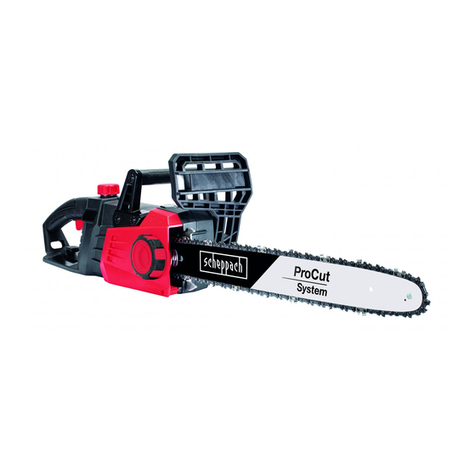
Scheppach
Scheppach CSE2700 Translation of original instruction manual
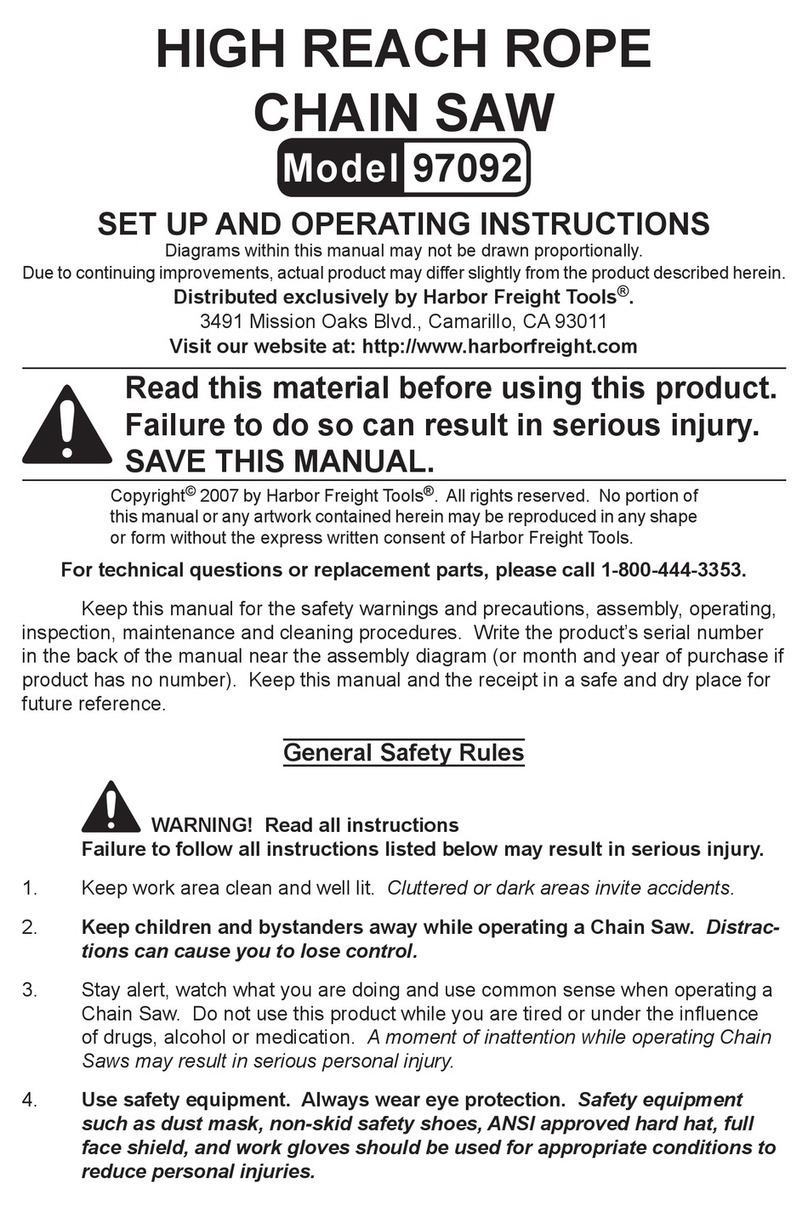
Harbor Freight Tools
Harbor Freight Tools 97092 Set up and operating instructions

Spear & Jackson
Spear & Jackson 37 cc Operation and maintenance manual





